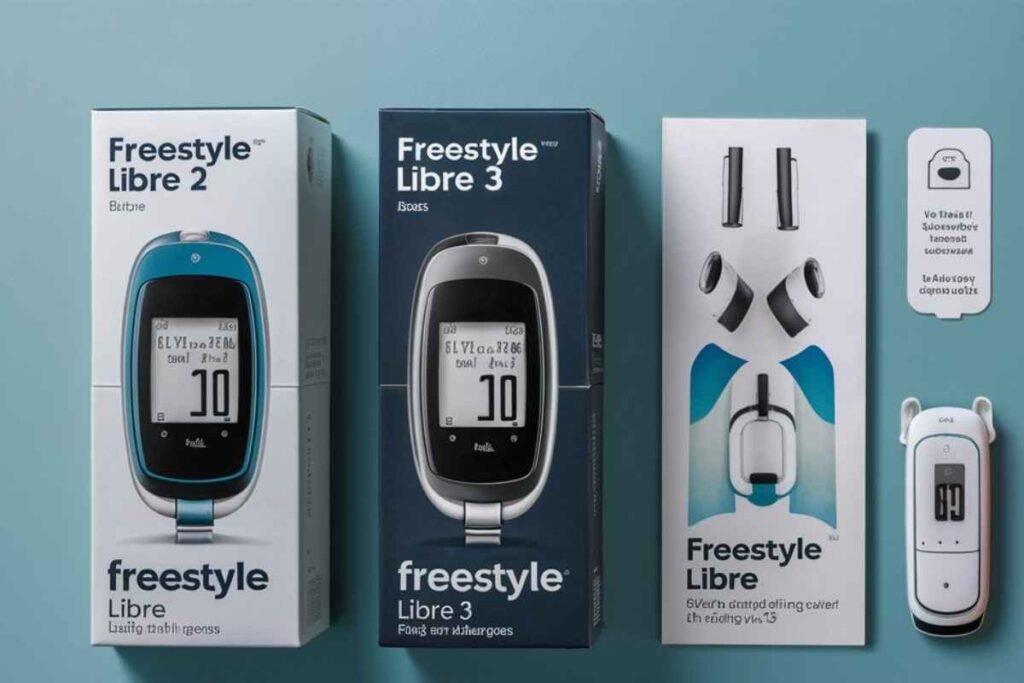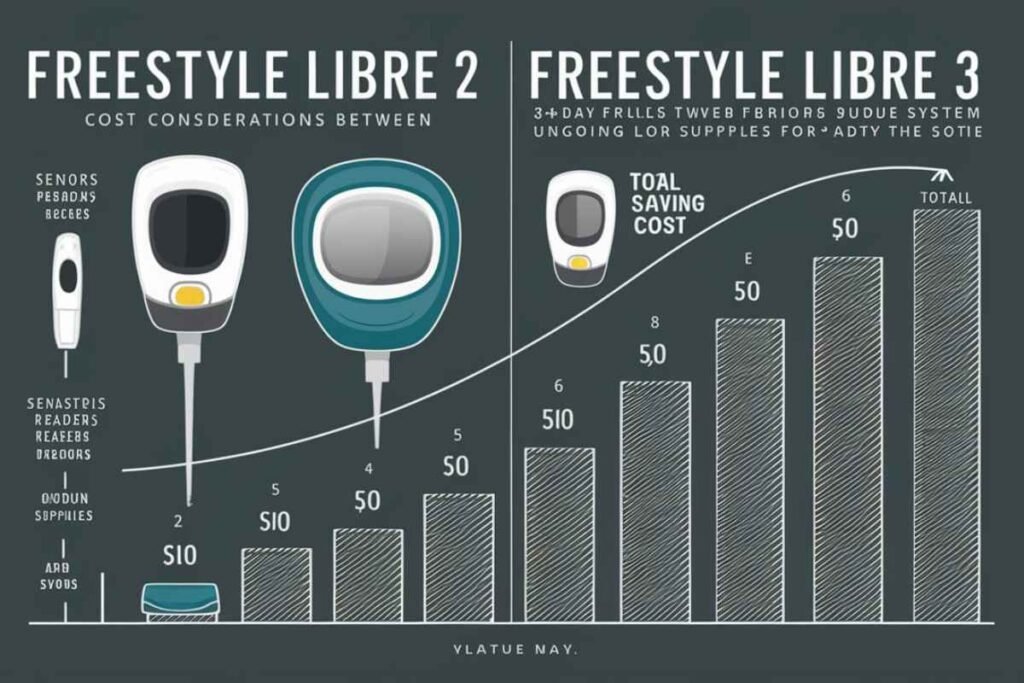
Table of Contents
In the realm of continuous glucose monitoring (CGM) systems, Abbott’s FreeStyle Libre series has established itself as a leading player, offering innovative solutions for individuals managing diabetes.
Among its latest offerings, the Freestyle Libre 2 vs 3 stand out as notable advancements in CGM technology.
Understanding the differences between these two systems is crucial for individuals seeking the most suitable option for their diabetes management needs.
In this comprehensive analysis, we delve deep into the features, functionalities, and user experiences of Freestyle Libre 2 vs 3 to provide valuable insights for potential users.
Understanding Continuous Glucose Monitoring (CGM)

Before delving into the specifics of Freestyle Libre 2 vs 3, it’s essential to grasp the fundamental principles of continuous glucose monitoring.
CGM systems serve as invaluable tools for individuals living with type 1 or type 2 diabetes, offering real-time insights into their blood glucose levels while minimizing the need for frequent finger stick tests.
These systems employ wearable sensors placed beneath the skin to continuously monitor glucose levels, transmitting data to a monitor or compatible smart device for convenient access.
Freestyle Libre 2 vs 3: An Overview
At the forefront of Abbott’s CGM lineup, both FreeStyle Libre 3 and FreeStyle Libre 2 offer features designed to enhance the user experience and streamline diabetes management.
However, several key distinctions set these systems apart, influencing factors such as sensor size, data accessibility, and overall convenience.
Sensor Size and Design
One of the most noticeable differences between FreeStyle Libre 3 and FreeStyle Libre 2 lies in the size and design of their sensors.
Abbott touts FreeStyle Libre 3 as the smallest sensor on the market, featuring a slim profile that prioritizes discretion and comfort.
In contrast, FreeStyle Libre 2 maintains a compact design but lacks the ultra-slim dimensions of its successor.
Users of FreeStyle Libre 3 often praise its minimalistic sensor, emphasizing its inconspicuous nature and reduced risk of snagging or dislodging.
Continuous Glucose Readings
A significant leap forward in CGM technology, FreeStyle Libre 3 introduces continuous glucose readings, eliminating the need for manual scans to access glucose data.
This real-time monitoring capability offers unparalleled convenience, allowing users to effortlessly track their glucose levels throughout the day without interruption.
In contrast, FreeStyle Libre 2 requires periodic scanning to obtain glucose readings, albeit with impressive accuracy and reliability.
Packaging and Insertion

In addition to sensor size, the packaging and insertion process represent areas of divergence between FreeStyle Libre 3 and FreeStyle Libre 2.
The introduction of FreeStyle Libre 3 brings forth a more streamlined insertion experience, characterized by an all-in-one applicator that simplifies sensor placement.
This user-friendly design minimizes the complexity associated with sensor insertion, enhancing overall convenience and ease of use.
Conversely, FreeStyle Libre 2 features a slightly bulkier applicator and packaging, albeit with comparable functionality and performance.
Data Accessibility and Connectivity
Connectivity options play a crucial role in determining the usability of CGM systems, particularly concerning data accessibility and device compatibility.
FreeStyle Libre 3 boasts seamless connectivity with compatible smartphones, enabling users to access glucose readings directly on their mobile devices.
This integration with smartphone apps enhances user convenience and accessibility, aligning with modern technological trends.
In contrast, FreeStyle Libre 2 offers compatibility with both dedicated readers and smartphones, providing users with flexibility in accessing their glucose data.
However, the absence of continuous glucose readings limits the real-time monitoring capabilities of FreeStyle Libre 2 compared to its successor.
Accuracy and Performance
When evaluating CGM systems, accuracy remains a paramount consideration for individuals relying on glucose data to inform their diabetes management decisions.
Abbott positions FreeStyle Libre 3 as a pinnacle of accuracy, boasting industry-leading performance metrics and minimal deviation from laboratory reference values.
While FreeStyle Libre 2 also delivers commendable accuracy, advancements in sensor technology and algorithmic improvements contribute to the superior performance of FreeStyle Libre 3.
Users of both systems report high levels of satisfaction with the accuracy and reliability of their glucose readings, underscoring the effectiveness of Abbott’s CGM solutions in real-world scenarios.
Availability and Market Reach
The availability of CGM systems varies across different regions, with regulatory approvals and market penetration influencing accessibility for users worldwide.
As an established product in Abbott’s portfolio, FreeStyle Libre 2 enjoys widespread availability in numerous countries, providing individuals with diabetes a reliable option for glucose monitoring.
In contrast, FreeStyle Libre 3 represents a newer entrant to the market, gradually expanding its reach through regulatory approvals and distribution channels.
While FreeStyle Libre 3 may not yet be accessible to all users globally, its growing availability underscores Abbott’s commitment to advancing diabetes care on a global scale.
Cost Considerations

Cost considerations play a significant role in the selection of CGM systems, particularly for individuals navigating healthcare expenses and insurance coverage.
Both FreeStyle Libre 3 and FreeStyle Libre 2 offer competitive pricing relative to other CGM options, making them accessible choices for individuals seeking reliable glucose monitoring solutions.
Factors such as sensor lifespan, device compatibility, and bundled offerings may influence the overall cost-effectiveness of each system, with users encouraged to explore available pricing options and reimbursement programs to maximize affordability.
Conclusion
In conclusion, the choice between Freestyle Libre 2 vs 3 hinges on individual preferences, priorities, and requirements for diabetes management.
While FreeStyle Libre 3 introduces groundbreaking features such as continuous glucose readings and enhanced sensor design, FreeStyle Libre 2 remains a dependable option with proven performance and widespread availability.
Ultimately, users should carefully evaluate the unique attributes of each system, considering factors such as sensor size, data accessibility, accuracy, and cost-effectiveness to make an informed decision.
With Abbott’s commitment to innovation and user-centric design, both Freestyle Libre 2 vs 3 exemplify advancements in CGM technology aimed at empowering individuals to live healthier, more manageable lives with diabetes.
FAQs
Can I wear the Libre 3 sensor in the shower and pool?
Yes, you can wear the Libre 3 sensor in the shower and pool.
What phones are compatible with the Libre 3?
Check the FreeStyle Libre website for a list of compatible phones.
Where is the Libre 3 sensor available?
The Libre 3 sensor availability varies by country; check with local suppliers for availability.
How much does Libre 3 cost?
The cost of the Libre 3 sensor may vary depending on your location and insurance coverage.
Which sensor is right for you?
Choose between Libre 2 and Libre 3 based on factors like availability, design preferences, and accuracy requirements.



Leave a Reply